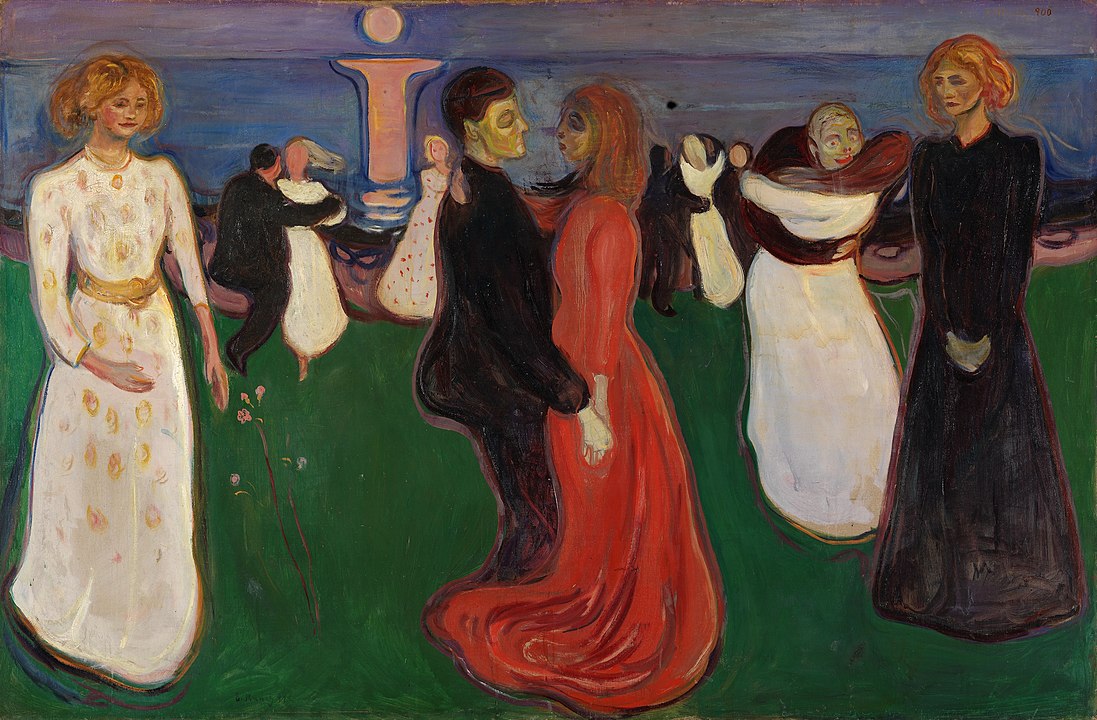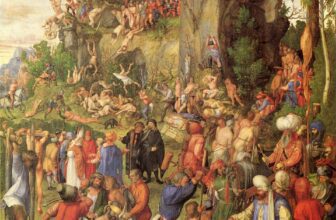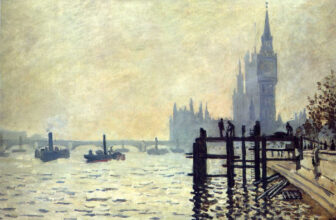
Meaning of The Dance of Life Painting by Edvard Munch
Edvard Munch, one of the most psychologically penetrating artists of the late 19th and early 20th centuries, created paintings that delve into the complexity of human emotions, existence, love, and death. Among his masterpieces, The Dance of Life (1899–1900) stands as a poignant, haunting, and deeply symbolic work that encapsulates many of the themes that preoccupied the Norwegian artist throughout his career. This painting forms part of his larger project, the Frieze of Life, a cycle of works that explore the stages of life, love, anxiety, and death.
In The Dance of Life, Munch captures the transient nature of human experience through a highly symbolic and emotionally charged composition. To truly appreciate this masterpiece, one must examine the background of its creation, the figures it portrays, the artistic style and techniques used, its symbolism, and where the painting resides today. This story post delves into all of these aspects, offering an in-depth understanding of one of Munch’s most significant works.
What is The Dance of Life All About?
At first glance, The Dance of Life portrays a simple scene: men and women dancing under the light of a full moon in a coastal setting. But this is no ordinary festive gathering. The scene is imbued with psychological depth and layered symbolism. The central couple is locked in a dance that appears both intimate and doomed. Around them are women in distinct poses and colors that suggest stages of life and emotional states.
This painting is about the passage of time, the fleeting nature of love, the inevitability of death, and the cyclical patterns of human experience. The mood is both melancholic and reflective, creating an atmosphere that draws viewers into the deeper existential questions that haunted Munch throughout his life.
The Artist and the Painting’s Creation
Edvard Munch (1863–1944) was a pioneer of Symbolist and Expressionist art. Born in Løten, Norway, Munch was deeply influenced by personal tragedy: the death of his mother when he was five and the subsequent death of his beloved sister when he was 14. These events instilled in him a lifelong preoccupation with illness, mortality, and psychological struggle.
The Dance of Life was painted around 1899 to 1900, during a critical phase in Munch’s career when he was working on the Frieze of Life series. Munch conceived this frieze as a poetic cycle portraying the emotional life of modern man, including themes of innocence, love’s blossoming, sexual anxiety, jealousy, and death.
During the time he painted The Dance of Life, Munch was influenced by a turbulent love affair with Tulla Larsen, which ended badly and left him emotionally scarred. Some art historians interpret The Dance of Life as an autobiographical work that reflects Munch’s own troubled experiences with intimacy and romantic relationships. He once wrote, “From my rotting body, flowers shall grow and I am in them and that is eternity.” This poetic statement reveals how deeply Munch associated life, death, and renewal , themes vividly present in The Dance of Life.
What Type of Art is The Dance of Life?
The Dance of Life is a quintessential example of Symbolist art, although it also exhibits early tendencies of Expressionism. Symbolism, a late 19th-century movement, rejected realism and naturalism in favor of art that conveyed deeper emotional truths through metaphor, myth, and dream imagery.
The painting also foreshadows the Expressionist movement, which Munch helped inspire. His use of bold color, distorted forms, and psychological intensity were central to Expressionism’s emphasis on subjective experience over realistic representation.
The color palette in The Dance of Life is both vivid and moody, with dramatic contrasts. The use of red, black, and white clothing on the women is symbolically charged, and the overall atmosphere is dreamlike, bordering on surreal. Munch’s brushstrokes are loose and expressive, enhancing the emotional tone of the work rather than focusing on precise detail.
Symbolism and Meaning: What is Happening in The Dance of Life?
The Dance of Life is more than a social scene , it is an allegory of the human journey from youth to death. The painting can be divided into three symbolic components, represented primarily through the three women in the foreground:
1. The Woman in White (Left) – Innocence and Youth
On the left side of the painting stands a young woman dressed in white. Her posture is shy and reserved. She looks toward the dancing couple with a mixture of curiosity and apprehension. This figure is widely interpreted as a symbol of innocent youth, untouched by the emotional complexities of love and sexuality. Her white dress signifies purity, and her position at the beginning of the scene suggests the start of life.
2. The Dancing Couple (Center) – Passion and Life
At the center is the heart of the composition: a man in a black suit dances with a woman in a flowing red dress. Her body molds around his; her face is pale and expressionless, almost corpse-like. The woman’s red dress is a powerful symbol of passion, fertility, and sensual love, but also hints at danger, blood, and emotional suffering. The man’s face appears withdrawn, even haunted, suggesting the alienation and tension often present in romantic relationships.
Many art historians argue that the dancing woman represents Munch’s former lover, Tulla Larsen, and that the dance is symbolic of a union tainted by emotional dissonance. The man may be a stand-in for Munch himself, entrapped in a relationship that oscillates between desire and dread.
3. The Woman in Black (Right) – Death and Mourning
On the far right, an older woman dressed in black stands alone, head bowed. Her posture is stooped and reflective. She is a stark contrast to the woman in white. Her black attire is a universal symbol of death, mourning, and the end of life. She is not dancing , she is observing, mourning, or remembering.
This triadic structure , maiden, lover, and crone , echoes ancient archetypes and serves to illustrate the cycle of life: from innocence to experience, to eventual decay and death. Munch draws heavily on psychological and mythological motifs to convey these eternal themes.
Composition and Space
The background of The Dance of Life adds further layers of meaning. The scene is set outdoors, along a shoreline under a full moon. The moon, a recurring symbol in Munch’s work, is often associated with femininity, mystery, and the unconscious mind. The sea, too, is symbolic , representing the vastness of existence, emotional depth, and the boundary between life and death.
Other dancing figures populate the midground, creating a sense of movement and continuity. These figures appear almost ghost-like, lacking the definition of the three main women. They suggest the ongoing, impersonal cycle of human lives, coming and going through time.
Psychological and Emotional Themes
Munch was deeply influenced by Freudian ideas about the unconscious and sexuality, even before Freud’s major works gained wide popularity. The painting can be viewed as a visualization of the emotional life cycle, where sexual love is both a driving force and a source of suffering.
The contrast between the static women and the moving dancers reflects the tension between time and timelessness, change and stasis, and life and death. The painting does not offer resolution; instead, it evokes a perpetual cycle , one where love begins in hope, culminates in union, and ends in isolation or mourning.
The Frieze of Life Context
The Dance of Life is one of the culminating pieces of the Frieze of Life, a series of artworks that include The Scream, Madonna, Ashes, The Kiss, and Death in the Sickroom. These works are unified by their exploration of emotional and existential themes.
Within this series, The Dance of Life acts as both a climax and a turning point. It portrays love not as a singular emotional high point, but as a phase embedded within the greater rhythm of life and death.
The Dance of Life is one of Munch’s most celebrated and studied works, not only for its aesthetic value but for its contribution to the evolution of modern art. The painting influenced many 20th-century artists, including German Expressionists like Ernst Ludwig Kirchner and Egon Schiele, who also explored emotional turbulence and inner psychology through bold color and distorted form.
Munch’s honest portrayal of vulnerability, desire, and existential dread paved the way for art to become a mirror of the soul, not just the physical world.
Current Location of the Painting
Today, The Dance of Life is housed in the National Museum of Art, Architecture and Design in Oslo, Norway. The museum holds one of the most comprehensive collections of Munch’s work in the world, including several key pieces from the Frieze of Life.
The painting continues to draw visitors from around the globe, who stand before it not just to admire its artistry but to connect with its timeless and universal themes.
Edvard Munch’s The Dance of Life is far more than a visual representation of people dancing. It is a profound meditation on the human condition , a symbolic narrative of life’s emotional and existential arc. Through masterful use of color, form, and symbolism, Munch invites us to reflect on the innocence of youth, the consuming passion of love, and the solitude of death.
In this painting, the figures do not merely dance with each other; they dance with time, memory, desire, and mortality. And as viewers, we are drawn into that eternal dance , recognizing ourselves in its rhythm, and perhaps, in its silence.
References:
National Museum of Norway – Edvard Munch Collection
Prideaux, Sue. Edvard Munch: Behind the Scream
Eggum, Arne. Edvard Munch: Paintings, Sketches, and Studies
Art Institute of Chicago – Symbolist Art and Psychological Themes
Gombrich, E.H. The Story of Art




